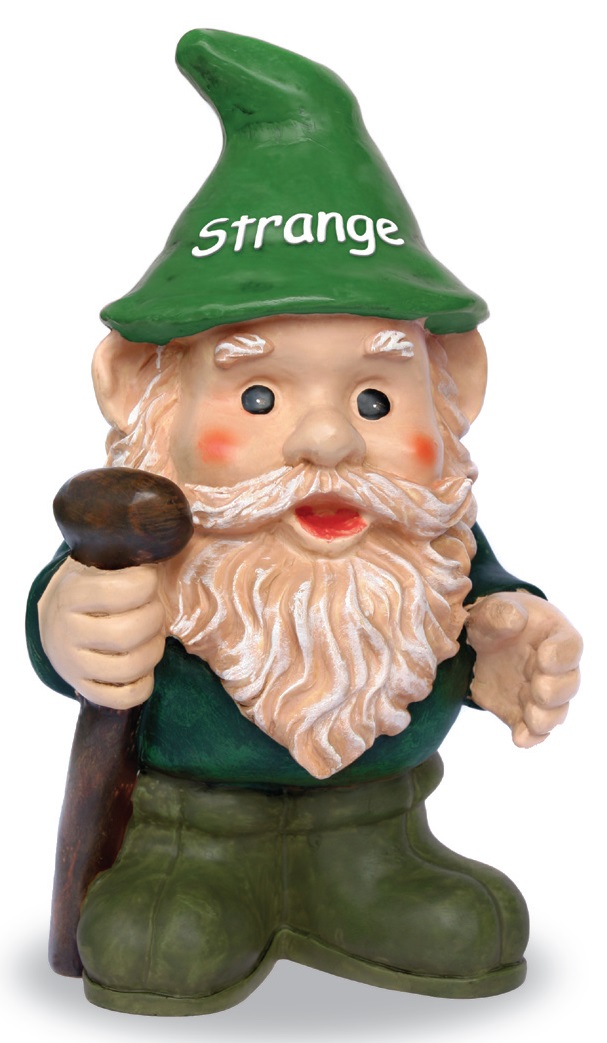Leptons and leprechauns
Dr. Maureen Hunter | TLT From the Editor March 2009
St. Patrick’s Day sets the stage for a few lessons in basic physics.

‘The year that my two older kids set up their traps for the 13th and 14th leprechauns, I was really nervous.’
For many years now, on the night before St. Patrick’s Day, my kids build traps to catch leprechauns. Somehow they always manage to catch one each. Well, not actual leprechauns but statues of leprechauns. It’s become a tradition in our house that every March we bring them out of storage and place them on the mantel. Last year we completed the set—24 in all.
Why 24? Well, that’s because of the name I gave the first one they caught. I named him Electron because leprechauns are believed to have negative personalities, and it almost rhymed.
An electron is one of six fundamental particles, called leptons, which never reside in an atom’s nucleus. The names of the other leptons, which, of course, had to be the names of the next five leprechauns we caught, are Tauon, Muon, Neutrino, Tauon Neutrino and Muon Neutrino. Tauon and Muon are negatively charged like Electron but are more massive. And the three members of the Neutrino family are electrically neutral.
When we caught the seventh leprechaun, I moved right to the antimatter lepton names—Positron, Anti-Tauon, Anti-Muon, Anti-Neutrino, Tauon Anti-Neutrino and Muon Anti-Neutrino. Since matter and antimatter of equal mass but opposite charge combine to annihilate each other, we place the matter- and antimatter-named leprechauns on the opposite sides of the mantel and never let them touch.
The year that my two older kids set up their traps for the 13th and 14th leprechauns, I was really nervous. There are only 12 leptons! What was I going to name those leprechauns? The only logical step was to move on to the quarks. Close enough, I thought. At least leprechauns look like quirky old men.
Quarks are the fundamental particles that reside inside an atom’s nucleus and combine in twos and threes to form protons, neutrons and other hadrons. There are six quarks that make up matter and six that make up antimatter. Quarks have fractional charges and different masses. And their names are fanciful—Up, Down, Charm, Strange, Top and Bottom.
The proton, with its plus one charge, is formed from two up quarks (each with a charge of plus two-thirds) and one down quark (with a minus one-third charge). The neutron is formed from two down quarks and one up quark, which results in its overall neutral charge. And then, of course, came the antiquarks—Anti-Up, Anti-Down, Anti-Charm, Anti-Strange, Anti-Top and Anti-Bottom. Little did these kids know about the physics lessons they were getting.
Now my four-year-old plans to catch the 25th leprechaun and even more in the future. But I’m not panicked yet about names. I’ll use the names of the force particles—Photon, Gluon, W Boson, Z Boson and the theoretical Graviton—that carry the four forces of nature (electromagnetic, strong, weak and gravity). That will buy me some time. And since matter and antimatter are believed to make up only 5% of our universe and the rest is believed to be dark (non-light emitting) matter and energy, I’m hoping that physicists will soon verify other classes of fundamental particles and more names for our leprechauns.
In String Theory, these fundamental particles and the force particles consists of a tiny, one-dimensional vibrating loop of energy. String Theory states that the observed particle properties are a reflection of the various ways in which a string can vibrate. The electron is a string vibrating one-way, the up quark is a string vibrating another way and so on and so on. Therefore, everything in the universe at its most microscopic level consists of combinations of vibrating strings. It might sound like a far-fetched dream, but this dream of a unified theory has become the Holy Grail of modern physics.
From the Big Bang to children’s dreams about leprechauns, this unified theory of everything may provide the firmest foundation on which to build our understanding of the world. Lepton or leprechaun—they’re both magical.
 Maureen Hunter is technical service manager for King Industries in Norwalk, Conn. You can reach her at mhunter@kingindustries.com
Maureen Hunter is technical service manager for King Industries in Norwalk, Conn. You can reach her at mhunter@kingindustries.com.